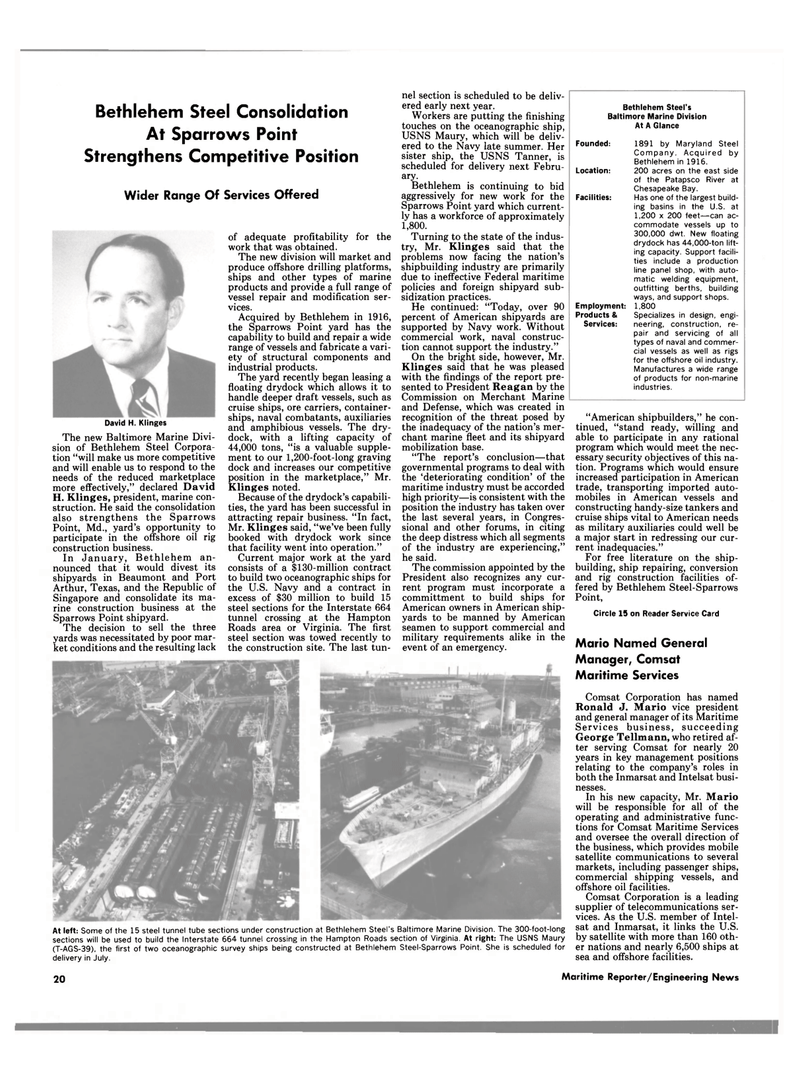
Page 18: of Maritime Reporter Magazine (May 1988)
Read this page in Pdf, Flash or Html5 edition of May 1988 Maritime Reporter Magazine
Bethlehem Steel's
Baltimore Marine Division
At A Glance 1891 by Maryland Steel
Company. Acquired by
Bethlehem in 1916. 200 acres on the east side of the Patapsco River at
Chesapeake Bay.
Has one of the largest build- ing basins in the U.S. at 1,200 x 200 feet—can ac- commodate vessels up to 300,000 dwt. New floating drydock has 44,000-ton lift- ing capacity. Support facili- ties include a production line panel shop, with auto- matic welding equipment, outfitting berths, building ways, and support shops.
Employment: 1,800
Products & Specializes in design, engi-
Services: neering, construction, re- pair and servicing of all types of naval and commer- cial vessels as well as rigs for the offshore oil industry.
Manufactures a wide range of products for non-marine industries.
Founded:
Location:
Facilities:
Bethlehem Steel Consolidation
At Sparrows Point
Strengthens Competitive Position
Wider Range Of Services Offered
The new Baltimore Marine Divi- sion of Bethlehem Steel Corpora- tion "will make us more competitive and will enable us to respond to the needs of the reduced marketplace more effectively," declared David
H. Klinges, president, marine con- struction. He said the consolidation also strengthens the Sparrows
Point, Md., yard's opportunity to participate in the offshore oil rig construction business.
In January, Bethlehem an- nounced that it would divest its shipyards in Beaumont and Port
Arthur, Texas, and the Republic of
Singapore and consolidate its ma- rine construction business at the
Sparrows Point shipyard.
The decision to sell the three yards was necessitated by poor mar- ket conditions and the resulting lack of adequate profitability for the work that was obtained.
The new division will market and produce offshore drilling platforms, ships and other types of marine products and provide a full range of vessel repair and modification ser- vices.
Acquired by Bethlehem in 1916, the Sparrows Point yard has the capability to build and repair a wide range of vessels and fabricate a vari- ety of structural components and industrial products.
The yard recently began leasing a floating drydock which allows it to handle deeper draft vessels, such as cruise ships, ore carriers, container- ships, naval combatants, auxiliaries and amphibious vessels. The dry- dock, with a lifting capacity of 44,000 tons, "is a valuable supple- ment to our 1,200-foot-long graving dock and increases our competitive position in the marketplace," Mr.
Klinges noted.
Because of the drydock's capabili- ties, the yard has been successful in attracting repair business. "In fact,
Mr. Klinges said, "we've been fully booked with drydock work since that facility went into operation."
Current major work at the yard consists of a $130-million contract to build two oceanographic ships for the U.S. Navy and a contract in excess of $30 million to build 15 steel sections for the Interstate 664 tunnel crossing at the Hampton
Roads area or Virginia. The first steel section was towed recently to the construction site. The last tun- nel section is scheduled to be deliv- ered early next year.
Workers are putting the finishing touches on the oceanographic ship,
USNS Maury, which will be deliv- ered to the Navy late summer. Her sister ship, the USNS Tanner, is scheduled for delivery next Febru- ary.
Bethlehem is continuing to bid aggressively for new work for the
Sparrows Point yard which current- ly has a workforce of approximately 1,800.
Turning to the state of the indus- try, Mr. Klinges said that the problems now facing the nation's shipbuilding industry are primarily due to ineffective Federal maritime policies and foreign shipyard sub- sidization practices.
He continued: "Today, over 90 percent of American shipyards are supported by Navy work. Without commercial work, naval construc- tion cannot support the industry."
On the bright side, however, Mr.
Klinges said that he was pleased with the findings of the report pre- sented to President Reagan by the
Commission on Merchant Marine and Defense, which was created in recognition of the threat posed by the inadequacy of the nation's mer- chant marine fleet and its shipyard mobilization base. "The report's conclusion—that governmental programs to deal with the 'deteriorating condition' of the maritime industry must be accorded high priority—is consistent with the position the industry has taken over the last several years, in Congres- sional and other forums, in citing the deep distress which all segments of the industry are experiencing," he said.
The commission appointed by the
President also recognizes any cur- rent program must incorporate a committment to build ships for
American owners in American ship- yards to be manned by American seamen to support commercial and military requirements alike in the event of an emergency. "American shipbuilders," he con- tinued, "stand ready, willing and able to participate in any rational program which would meet the nec- essary security objectives of this na- tion. Programs which would ensure increased participation in American trade, transporting imported auto- mobiles in American vessels and constructing handy-size tankers and cruise ships vital to American needs as military auxiliaries could well be a major start in redressing our cur- rent inadequacies."
For free literature on the ship- building, ship repairing, conversion and rig construction facilities of- fered by Bethlehem Steel-Sparrows
Point,
Circle 15 on Reader Service Card
Mario Named General
Manager, Comsat
Maritime Services
At left: Some of the 15 steel tunnel tube sections under construction at Bethlehem Steel's Baltimore Marine Division. The 300-foot-long sections will be used to build the Interstate 664 tunnel crossing in the Hampton Roads section of Virginia. At right: The USNS Maury (T-AGS-39), the first of two oceanographic survey ships being constructed at Bethlehem Steel-Sparrows Point. She is scheduled for delivery in July.
Comsat Corporation has named
Ronald J. Mario vice president and general manager of its Maritime
Services business, succeeding
George Tellmann, who retired af- ter serving Comsat for nearly 20 years in key management positions relating to the company's roles in both the Inmarsat and Intelsat busi- nesses.
In his new capacity, Mr. Mario will be responsible for all of the operating and administrative func- tions for Comsat Maritime Services and oversee the overall direction of the business, which provides mobile satellite communications to several markets, including passenger ships, commercial shipping vessels, and offshore oil facilities.
Comsat Corporation is a leading supplier of telecommunications ser- vices. As the U.S. member of Intel- sat and Inmarsat, it links the U.S. by satellite with more than 160 oth- er nations and nearly 6,500 ships at sea and offshore facilities.
David H. Klinges 20 Maritime Reporter/Engineering News

 17
17

 19
19
